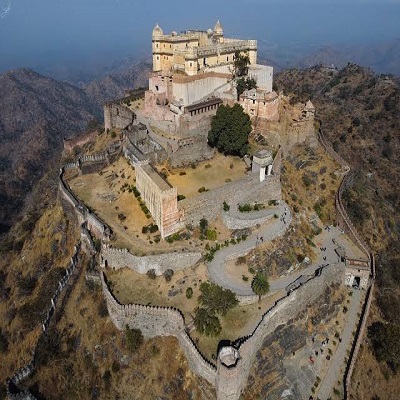
Kumbhalgarh (literally "Kumbhal fort"), also known as the Great Wall of India, is a Mewar fortress on the westerly range of Aravalli Hills, just about 48 km from Rajsamand city in the Rajsamand district of the Rajasthan state in western India. It is located about 84 km from Udaipur. It is a World Heritage Site included in Hill Forts of Rajasthan. It was built during the 15th century by Rana Kumbha. In 2013, at the 37th session of the World Heritage Committee held in Phnom Penh, Cambodia, Kumbhalgarh Fort, along with five other forts of Rajasthan, was declared a UNESCO World Heritage Site under the group Hill Forts of Rajasthan. The chief architect who built this fort was Mandan, who documented his style of work in his text, Rajvallabh. The fort is among the largest fort complexes in the world.
The early history of the fort could not be ascertained on account of lack of evidence. Before Rana Kumbha built the new fort, there was a small fort, limited to small hilly area, believed to have been built by King Samprati of the Maurya and was known as Matsyaendra Durg. Rana Lakha won this entire area and plains of Godwar from Chauhan Rajputs of Nadol in late 14th century. Kumbhalgarh, as the fort we see it was built by Rana Kumbha who was the Rana of Mewar from the Sisodia rajput clan. Rana Kumbha took the aid of the famous architect of the era, "Mandan". Rana Kumbha's kingdom of Mewar stretched from Ranthambore to Gwalior and included large tracts of what is now Madhya Pradesh and Rajasthan. Out of the 84 forts in his dominion, Rana Kumbha is said to have built 32 of them, of which Kumbhalgarh is the largest and most elaborate.
Built on a hilltop 1,100 m (3,600 ft) above sea level on the Aravalli range, the fort of Kumbhalgarh has perimeter walls that extend 36 km (22 mi), making it among the longest walls in the world. The frontal walls are fifteen feet thick. Kumbhalgarh has seven fortified gateways. There are over 70 temples within the fort, both Jain and Hindu Temples. From the palace top, it is possible to see Kilometres into the Aravalli Range.